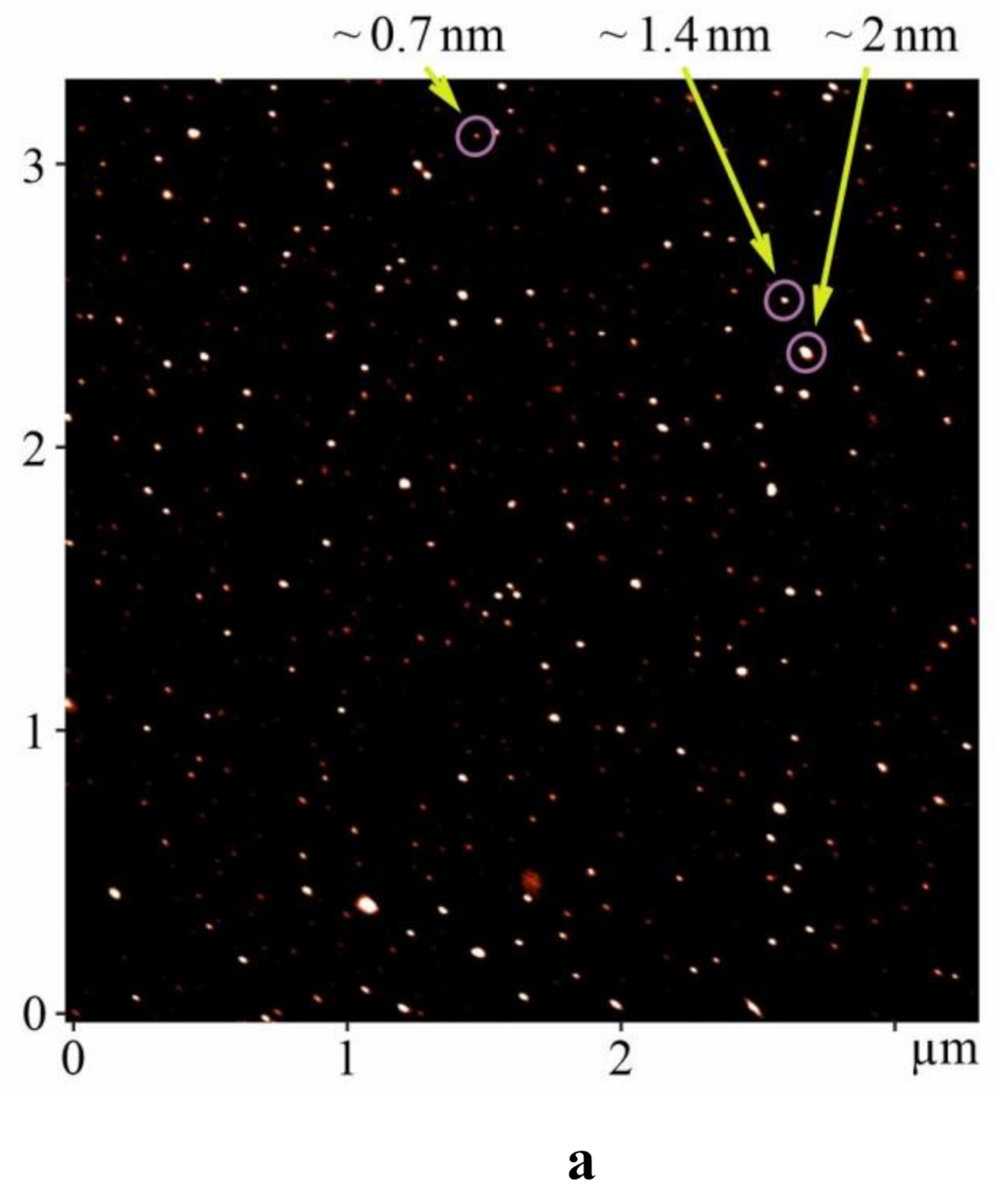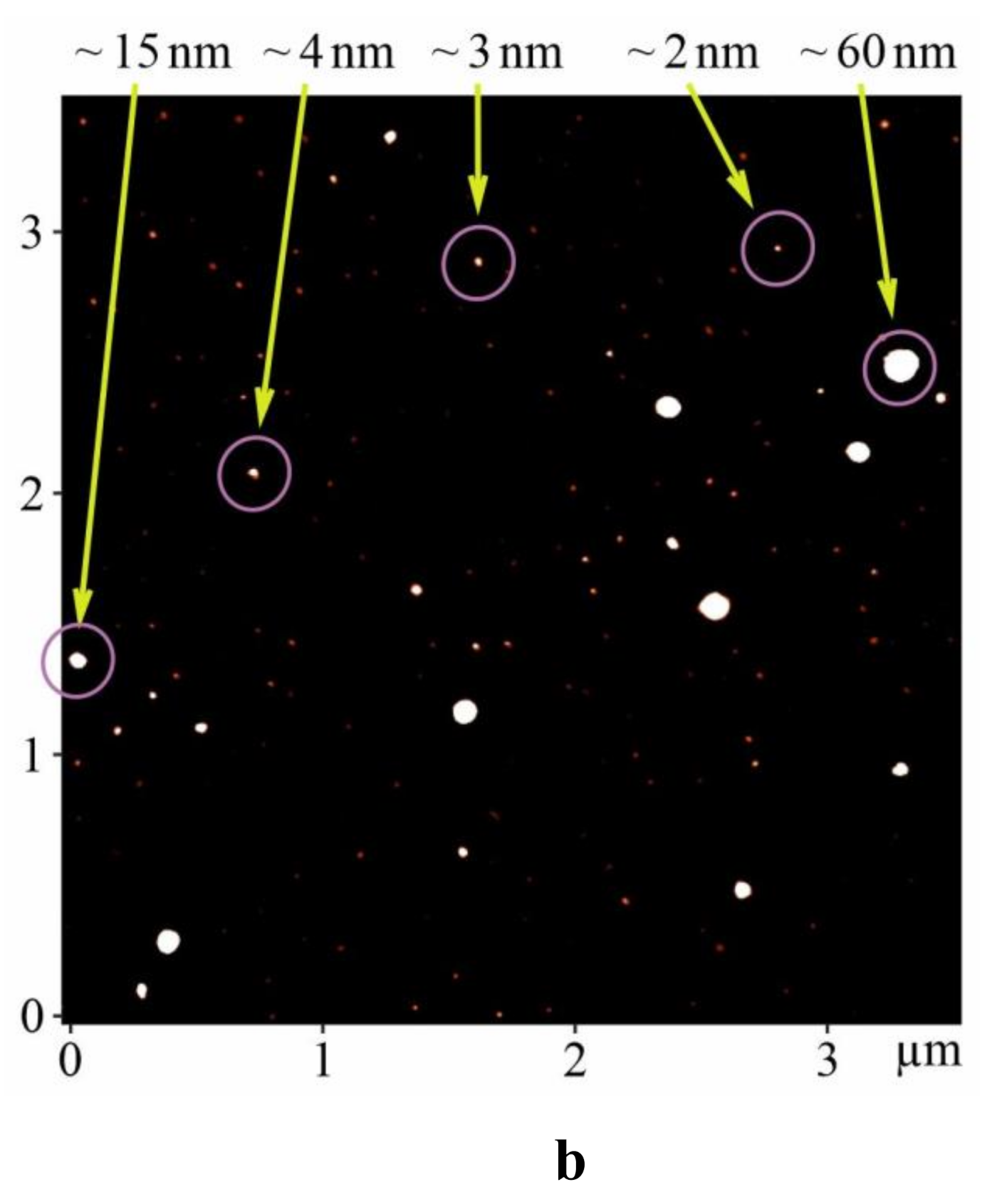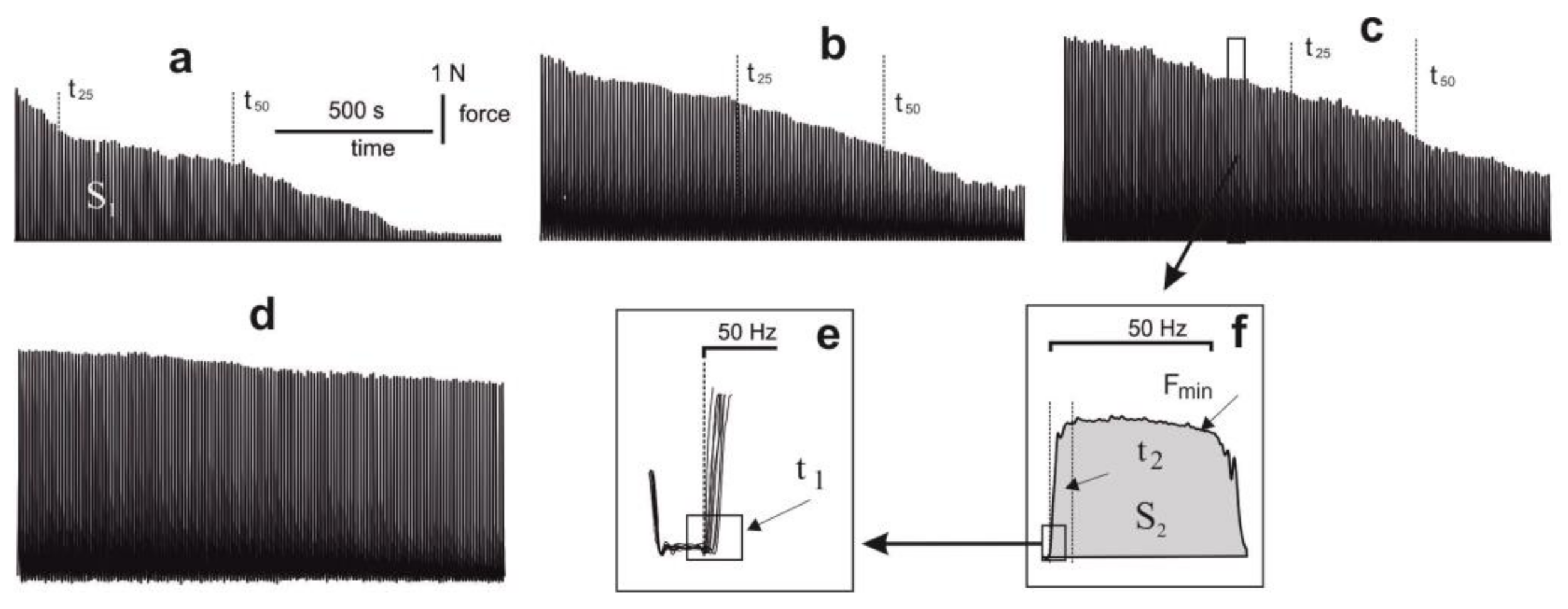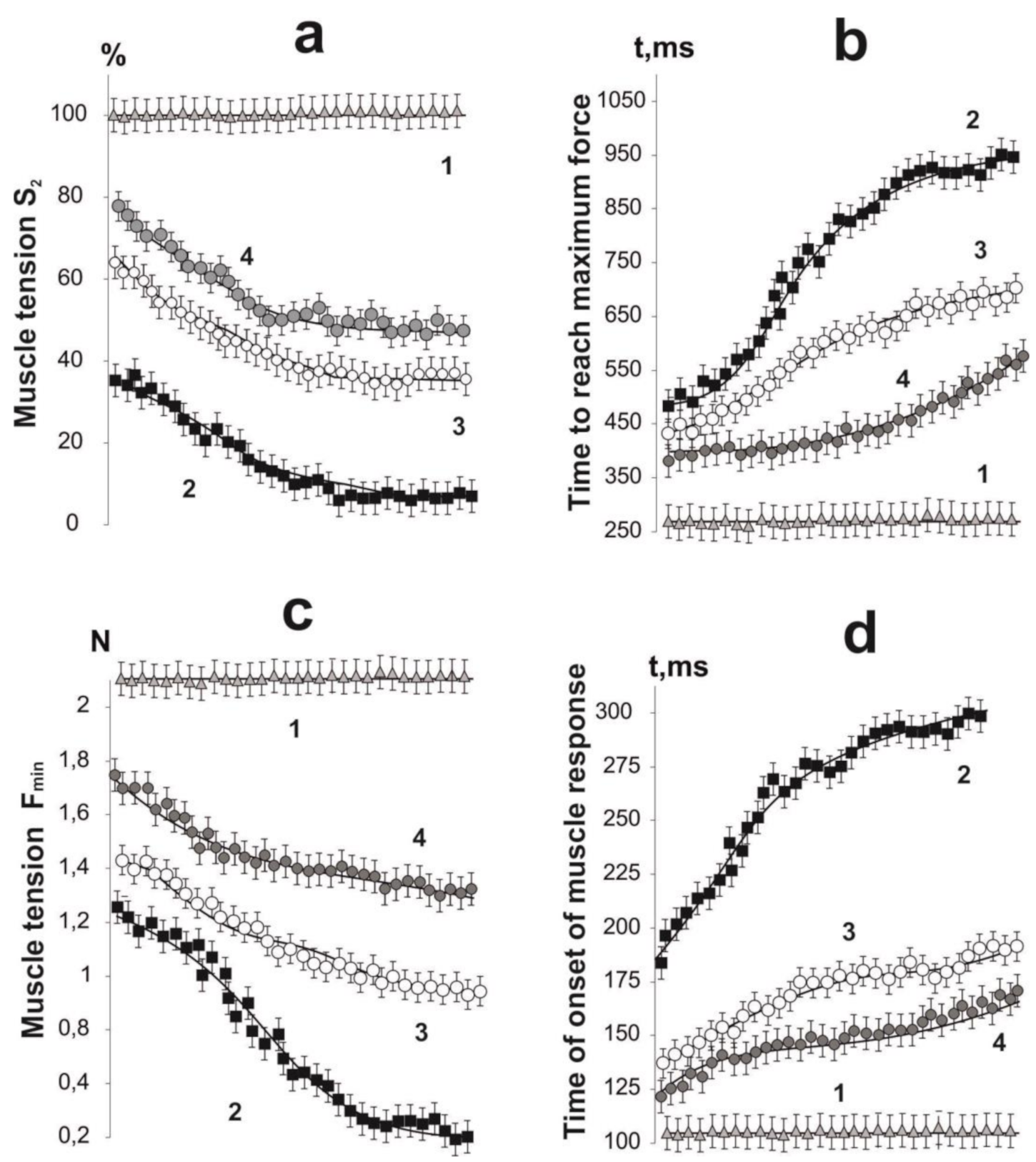Analysis of Biomechanical Parameters of Muscle Soleus Contraction and Blood Biochemical Parameters in Rat with Chronic Glyphosate Intoxication and Therapeutic Use of C60 Fullerene
Abstract
1. Introduction
2. Results and Discussion
2.1. AFM Analysis
2.2. Biomechanical Analysis
2.3. Biochemical Analysis
3. Materials and Methods
4. Conclusions
Author Contributions
Funding
Institutional Review Board Statement
Informed Consent Statement
Data Availability Statement
Acknowledgments
Conflicts of Interest
References
- Benbrook, C.M. Trends in glyphosate herbicide use in the United States and globally. Environ. Sci. Eur. 2016, 28, 1–15. [Google Scholar] [CrossRef] [PubMed]
- Van Bruggen, A.H.C.; He, M.M.; Shin, K.; Mai, V.; Jeong, K.C.; Finckh, M.R.; Morris, J.G., Jr. Environmental and health effects of the herbicide glyphosate. Sci. Total Environ. 2018, 616–617, 255–268. [Google Scholar] [CrossRef] [PubMed]
- Portier, C.J. A comprehensive analysis of the animal carcinogenicity data for glyphosate from chronic exposure rodent carcinogenicity studies. Environ. Health 2020, 19, 18. [Google Scholar] [CrossRef] [PubMed]
- Chłopecka, M.; Mendel, M.; Dzieka, N.; Wojciech, K. Glyphosate affects the spontaneous motoric activity of intestine at very low doses—In vitro study. Pestic. Biochem. Physiol. 2014, 113, 25–30. [Google Scholar] [CrossRef] [PubMed]
- Zhidenko, A.A.; Bibchuk, E.V.; Barbukho, E.V. Effect of glyphosate on the energy exchange in carp organs. Ukr. Kyi Biokhimichnyi Zhurnal 2013, 85, 22–30. [Google Scholar] [CrossRef] [PubMed]
- Lopes, F.M.; Caldas, S.S.; Primel, E.G.; da Rosa, C.E. Glyphosate adversely affects Danio rerio males: Acetylcholinesterase modulation and oxidative stress. Zebrafish 2017, 14, 97–105. [Google Scholar] [CrossRef] [PubMed]
- Dornelles, M.F.; Oliveira, G.T. Toxicity of atrazine, glyphosate, and quinclorac in bullfrog tadpoles exposed to concentrations below legal limits. Environ. Sci. Pollut. Res. Int. 2016, 23, 1610–1620. [Google Scholar] [CrossRef] [PubMed]
- Bradberry, S.M.; Proudfoot, A.T.; Vale, J.A. Glyphosate poisoning. Toxicol. Rev. 2004, 23, 159–167. [Google Scholar] [CrossRef]
- Cattaneo, R.; Clasen, B.; Loro, V.L.; de Menezes, C.C.; Pretto, A.; Baldisserotto, B.; Santi, A.; de Avila, L.A. Toxicological responses of Cyprinus carpio exposed to a commercial formulation containing glyphosate. Bull. Environ. Contam. Toxicol. 2011, 87, 597–602. [Google Scholar] [CrossRef]
- Krusic, P.J.; Wasserman, E.; Keizer, P.N.; Morton, J.R.; Preston, K.F. Radical reactions of C60. Science 1991, 254, 1183–1185. [Google Scholar] [CrossRef]
- Ferreira, C.A.; Ni, D.; Rosenkrans, Z.T.; Cai, W. Scavenging of reactive oxygen and nitrogen species with nanomaterials. Nano Res. 2018, 11, 4955–4984. [Google Scholar] [CrossRef]
- Halenova, T.; Raksha, N.; Savchuk, O.; Ostapchenko, L.; Prylutskyy, Y.; Ritter, U.; Scharff, P. Evaluation of the biocompatibility of water-soluble pristine C60 fullerenes in rabbit. BioNanoScience 2020, 10, 721–730. [Google Scholar] [CrossRef]
- Nozdrenko, D.M.; Zavodovsky, D.O.; Matvienko, T.Y.; Zay, S.Y.; Bogutska, K.I.; Prylutskyy, Y.I.; Ritter, U.; Scharff, P. C60 fullerene as promising therapeutic agent for the prevention and correction of functioning skeletal muscle at ischemic injury. Nanoscale Res. Lett. 2017, 12, 1–9. [Google Scholar] [CrossRef]
- Vereshchaka, I.V.; Bulgakova, N.V.; Maznychenko, A.V.; Gonchar, O.O.; Prylutskyy, Yu.I.; Ritter, U.; Moska, W.; Tomiak, T.; Nozdrenko, D.M.; Mishchenko, I.V.; et al. C60 fullerenes diminish the muscle fatigue in rats comparable to N-acetylcysteine or β-alanine. Front. Physiol. 2018, 9, 517. [Google Scholar] [CrossRef]
- Halenova, T.I.; Vareniuk, I.M.; Roslova, N.M.; Dzerzhynsky, M.E.; Savchuk, O.M.; Ostapchenko, L.I.; Prylutskyy, Yu.I.; Ritter, U.; Scharff, P. Hepatoprotective effect of orally applied water-soluble pristine C60 fullerene against CCl4-induced acute liver injury in rats. RSC Adv. 2016, 6, 100046–100055. [Google Scholar] [CrossRef]
- Lynchak, O.V.; Prylutskyy, Yu.I.; Rybalchenko, V.K.; Kyzyma, O.A.; Soloviov, D.; Kostjukov, V.V.; Evstigneev, M.P.; Ritter, U.; Scharff, P. Comparative analysis of the antineoplastic activity of C60 fullerene with 5-fluorouracil and pyrrole derivative in vivo. Nanoscale Res. Lett. 2017, 12, 1–6. [Google Scholar] [CrossRef]
- Halenova, T.I.; Raksha, N.G.; Vovk, T.B.; Savchuk, O.M.; Ostapchenko, L.I.; Prylutskyy, Yu.I.; Kyzyma, O.A.; Ritter, U.; Scharff, P. Effect of C60 fullerene nanoparticles on the diet-induced obesity in rats. Int. J. Obes. 2018, 42, 1987–1998. [Google Scholar] [CrossRef]
- Kuznietsova, H.M.; Lynchak, O.V.; Dziubenko, N.V.; Osetskyi, V.L.; Ogloblya, O.V.; Prylutskyy, Yu.I.; Rybalchenko, V.K.; Ritter, U.; Scharff, P. Water-soluble C60 fullerenes reduce manifestations of acute cholangitis in rats. Appl. Nanosci. 2019, 9, 601–608. [Google Scholar] [CrossRef]
- Maznychenko, A.V.; Mankivska, O.P.; Sokolowska, I.V.; Kopyak, B.S.; Tomiak, T.; Bulgakova, N.V.; Gonchar, O.O.; Prylutskyy, Y.I.; Ritter, U.; Mishchenko, I.V.; et al. C60 fullerenes increase the intensity of rotational movements in non-anesthetized hemiparkinsonic rats. Acta Neurobiol. Exp. 2020, 80, 32–37. [Google Scholar]
- Kuznietsova, H.; Dziubenko, N.; Herheliuk, T.; Prylutskyy, Yu.; Tauscher, E.; Ritter, U.; Scharff, P. Water-soluble pristine C60 fullerene inhibits liver alterations associated with hepatocellular carcinoma in rat. Pharmaceutics 2020, 12, 794. [Google Scholar] [CrossRef]
- Lyon, D.Y.; Adams, L.K.; Falkner, J.C.; Alvarezt, P.J. Antibacterial activity of fullerene water suspensions: Effects of preparation method and particle size. Environ. Sci. Technol. 2006, 40, 4360–4366. [Google Scholar] [CrossRef]
- Zhang, B.; Bian, W.; Pal, A.; He, Y. Macrophage apoptosis induced by aqueous C60 aggregates changing the mitochondrial membrane potential. Environ. Toxicol. Pharmacol. 2015, 39, 237–246. [Google Scholar] [CrossRef]
- Sayers, B.C.; Germolec, D.R.; Walker, N.J.; Shipkowski, K.A.; Stout, M.D.; Cesta, M.F.; Roycroft, J.H.; White, K.L.; Baker, G.L.; Dill, J.A.; et al. Respiratory toxicity and immunotoxicity evaluations of microparticle and nanoparticle C60 fullerene aggregates in mice and rats following nose-only inhalation for 13 weeks. Nanotoxicology 2016, 10, 1458–1468. [Google Scholar] [CrossRef]
- Melnyk, M.I.; Ivanova, I.V.; Dryn, D.O.; Prylutskyy, Yu.I.; Hurmach, V.V.; Platonov, M.; Al Kury, L.T.; Ritter, U.; Soloviev, A.I.; Zholos, A.V. C60 fullerenes selectively inhibit BKCa but not Kv channels in pulmonary artery smooth muscle cells. Nanomed. Nanotechnol. Biol. Med. 2019, 19, 1–11. [Google Scholar] [CrossRef] [PubMed]
- Prylutska, S.V.; Grebinyk, A.G.; Lynchak, O.V.; Byelinska, I.V.; Cherepanov, V.V.; Tauscher, E.; Matyshevska, O.P.; Prylutskyy, Yu.I.; Rybalchenko, V.K.; Ritter, U.; et al. In vitro and in vivo toxicity of pristine C60 fullerene aqueous colloid solution. Fuller. Nanotub. Carbon Nanostructures 2019, 27, 715–728. [Google Scholar] [CrossRef]
- Schuetze, C.; Ritter, U.; Scharff, P.; Bychko, A.; Prylutska, S.; Rybalchenko, V.; Prylutskyy, Yu. Interaction of N-fluorescein-5-isothiocyanate pyrrolidine-C60 compound with a model bimolecular lipid membrane. Mater. Sci. Eng. C 2011, 31, 1148–1150. [Google Scholar] [CrossRef]
- Ritter, U.; Prylutskyy, Yu.I.; Evstigneev, M.P.; Davidenko, N.A.; Cherepanov, V.V.; Senenko, A.I.; Marchenko, O.A.; Naumovets, A.G. Structural features of highly stable reproducible C60 fullerene aqueous colloid solution probed by various techniques. Fuller. Nanotub. Carbon Nanostructures 2015, 23, 530–534. [Google Scholar] [CrossRef]
- Skamrova, G.B.; Laponogov, I.; Buchelnikov, A.S.; Shckorbatov, Y.G.; Prylutska, S.V.; Ritter, U.; Prylutskyy, Y.I.; Evstigneev, M.P. Interceptor effect of C60 fullerene on the in vitro action of aromatic drug molecules. Eur. Biophys. J. 2014, 43, 265–276. [Google Scholar] [CrossRef]
- Menéndez-Helman, R.J.; Miranda, A.L.; Dos Santos Afonso, M.; Salibián, A. Subcellular energy balance of Odontesthes bonariensis exposed to a glyphosate-based herbicide. Ecotoxicol. Environ. Saf. 2015, 114, 157–163. [Google Scholar] [CrossRef]
- Gallegos, C.E.; Bartos, M.; Bras, C.; Gumilar, F.; Antonelli, M.C.; Minetti, A. Exposure to a glyphosate-based herbicide during pregnancy and lactation induces neurobehavioral alterations in rat offspring. Neurotoxicology 2016, 53, 20–28. [Google Scholar] [CrossRef]
- Nozdrenko, D.M.; Miroshnychenko, M.S.; Soroca, V.M.; Korchinska, L.V.; Zavodovskiy, D.O. The effect of chlorpyrifos upon ATPase activity of sarcoplasmic reticulum and biomechanics of skeletal muscle contraction. Ukr. Biochem. J. 2016, 88, 82–88. [Google Scholar] [CrossRef]
- Nozdrenko, D.M.; Abramchuk, O.M.; Soroca, V.M.; Miroshnichenko, N.S. Aluminum chloride effect on Ca2+,Mg2+-ATPase activity and dynamic parameters of skeletal muscle contraction. Ukr. Biochem. J. 2015, 87, 38–45. [Google Scholar] [CrossRef]
- Nozdrenko, D.M.; Korchinska, L.V.; Soroca, V.M. Activity of Ca(2+),Mg(2+)-ATPase of sarcoplasmic reticulum and contraction strength of the frog skeletal muscles under the effect of organophosphorus insecticides. Ukr. Biochem. J. 2015, 87, 63–69. [Google Scholar] [CrossRef]
- Thakur, D.S.; Khot, R.; Joshi, P.P.; Pandharipande, M.; Nagpure, K. Glyphosate poisoning with acute pulmonary edema. Toxicol. Int. 2014, 21, 328–330. [Google Scholar] [CrossRef]
- Gonchar, O.O.; Maznychenko, A.V.; Bulgakova, N.V.; Vereshchaka, I.V.; Tomiak, T.; Ritter, U.; Prylutskyy, Yu.I.; Mankovska, I.M.; Kostyukov, A.I. C60 fullerene prevents restraint stress-induced oxidative disorders in rat tissues: Possible involvement of the Nrf2/ARE-antioxidant pathway. Oxid. Med. Cell. Longev. 2018, 2018, 2518676. [Google Scholar] [CrossRef]
- Stur, E.; Aristizabal-Pachon, A.F.; Peronni, K.C.; Agostini, L.P.; Waigel, S.; Chariker, J.; Miller, D.M.; Thomas, S.D.; Rezzoug, F.; DeTogni, R.S.; et al. Glyphosate-based herbicides at low doses affect canonical pathways in estrogen positive and negative breast cancer cell lines. PLoS ONE 2019, 14, e0219610. [Google Scholar] [CrossRef]
- Russ, K.A.; Elvati, P.; Parsonage, T.L.; Dews, A.; Jarvis, J.A.; Ray, M.; Schneider, B.; Smith, P.J.S.; Williamson, P.T.F.; Violi, A.; et al. C60 fullerene localization and membrane interactions in RAW 264.7 immortalized mouse macrophages. Nanoscale 2016, 8, 4134–4144. [Google Scholar] [CrossRef]
- Eswaran, S.V. Water soluble nanocarbon materials: A panacea for all? Curr. Sci. 2018, 114, 1846–1850. [Google Scholar] [CrossRef]
- Scharff, P.; Carta-Abelmann, L.; Siegmund, C.; Matyshevska, O.P.; Prylutska, S.V.; Koval, T.V.; Golub, A.A.; Yashchuk, V.M.; Kushnir, K.M.; Prylutskyy, Yu.I. Effect of X-ray and UV irradiation of the C60 fullerene aqueous solution on biological samples. Carbon 2004, 42, 1199–1201. [Google Scholar] [CrossRef]
- Gharbi, N.; Pressac, M.; Hadchouel, M.; Szwarc, H.; Wilson, S.R.; Moussa, F. Fullerene is a powerful antioxidant in vivo with no acute or subacute toxicity. Nano Lett. 2005, 5, 2578–2585. [Google Scholar] [CrossRef]
- Nozdrenko, D.N.; Berehovyi, S.M.; Nikitina, N.S.; Stepanova, L.I.; Beregova, T.V.; Ostapchenko, L.I. The influence of complex drug cocarnit on the nerve conduction velocity in nerve tibialis of rats with diabetic polyneuropathy. Biomed. Res. 2018, 29, 3629. [Google Scholar]
- Brancaccio, P.; Lippi, G.; Maffulli, N. Biochemical markers of muscular damage. Clin. Chem. Lab. Med. 2010, 48, 757–767. [Google Scholar] [CrossRef]







Publisher’s Note: MDPI stays neutral with regard to jurisdictional claims in published maps and institutional affiliations. |
© 2021 by the authors. Licensee MDPI, Basel, Switzerland. This article is an open access article distributed under the terms and conditions of the Creative Commons Attribution (CC BY) license (https://creativecommons.org/licenses/by/4.0/).
Share and Cite
Nozdrenko, D.; Abramchuk, O.; Prylutska, S.; Vygovska, O.; Soroca, V.; Bogutska, K.; Khrapatyi, S.; Prylutskyy, Y.; Scharff, P.; Ritter, U. Analysis of Biomechanical Parameters of Muscle Soleus Contraction and Blood Biochemical Parameters in Rat with Chronic Glyphosate Intoxication and Therapeutic Use of C60 Fullerene. Int. J. Mol. Sci. 2021, 22, 4977. https://doi.org/10.3390/ijms22094977
Nozdrenko D, Abramchuk O, Prylutska S, Vygovska O, Soroca V, Bogutska K, Khrapatyi S, Prylutskyy Y, Scharff P, Ritter U. Analysis of Biomechanical Parameters of Muscle Soleus Contraction and Blood Biochemical Parameters in Rat with Chronic Glyphosate Intoxication and Therapeutic Use of C60 Fullerene. International Journal of Molecular Sciences. 2021; 22(9):4977. https://doi.org/10.3390/ijms22094977
Chicago/Turabian StyleNozdrenko, Dmytro, Olga Abramchuk, Svitlana Prylutska, Oksana Vygovska, Vasil Soroca, Kateryna Bogutska, Sergii Khrapatyi, Yuriy Prylutskyy, Peter Scharff, and Uwe Ritter. 2021. "Analysis of Biomechanical Parameters of Muscle Soleus Contraction and Blood Biochemical Parameters in Rat with Chronic Glyphosate Intoxication and Therapeutic Use of C60 Fullerene" International Journal of Molecular Sciences 22, no. 9: 4977. https://doi.org/10.3390/ijms22094977
APA StyleNozdrenko, D., Abramchuk, O., Prylutska, S., Vygovska, O., Soroca, V., Bogutska, K., Khrapatyi, S., Prylutskyy, Y., Scharff, P., & Ritter, U. (2021). Analysis of Biomechanical Parameters of Muscle Soleus Contraction and Blood Biochemical Parameters in Rat with Chronic Glyphosate Intoxication and Therapeutic Use of C60 Fullerene. International Journal of Molecular Sciences, 22(9), 4977. https://doi.org/10.3390/ijms22094977







